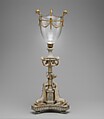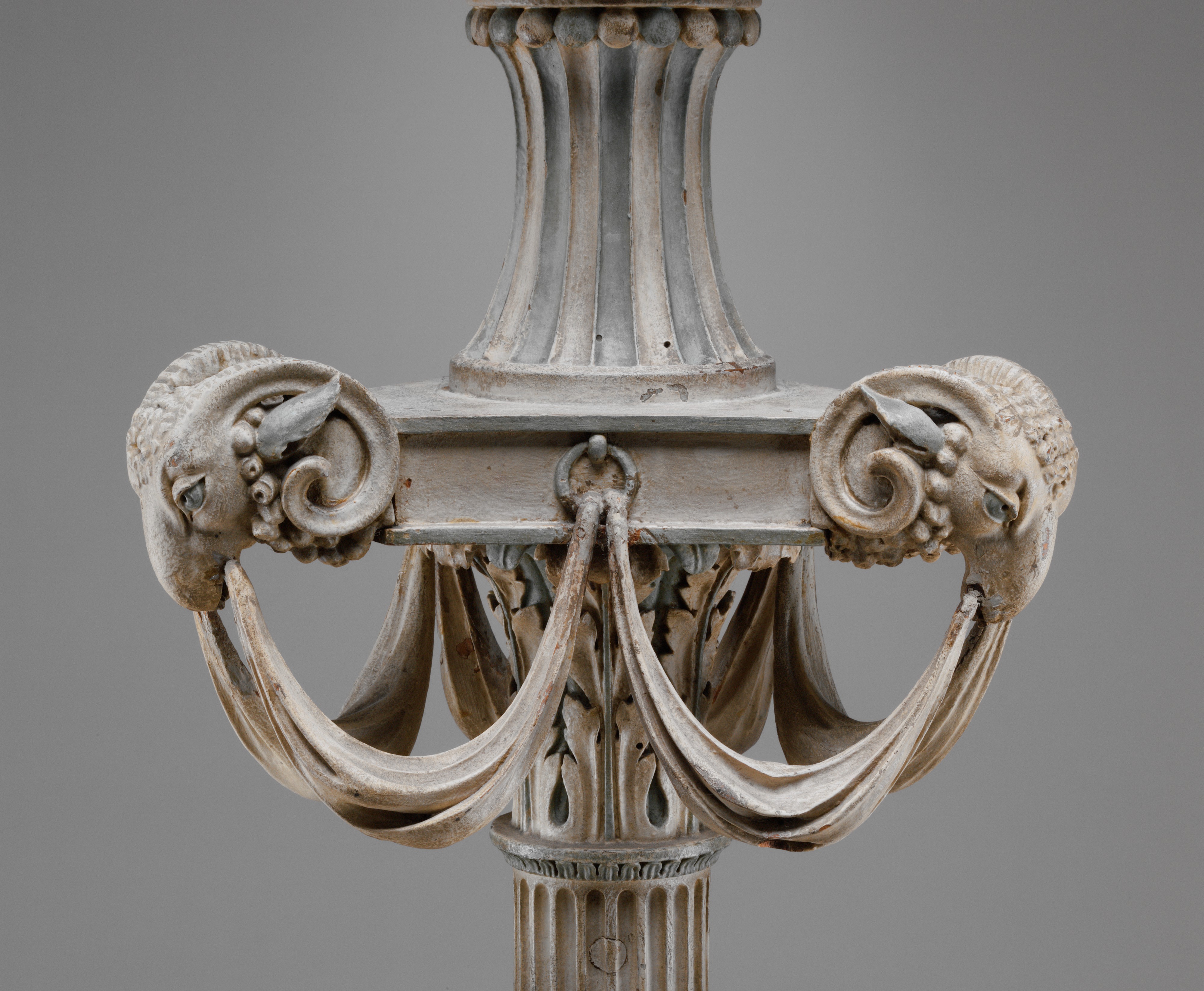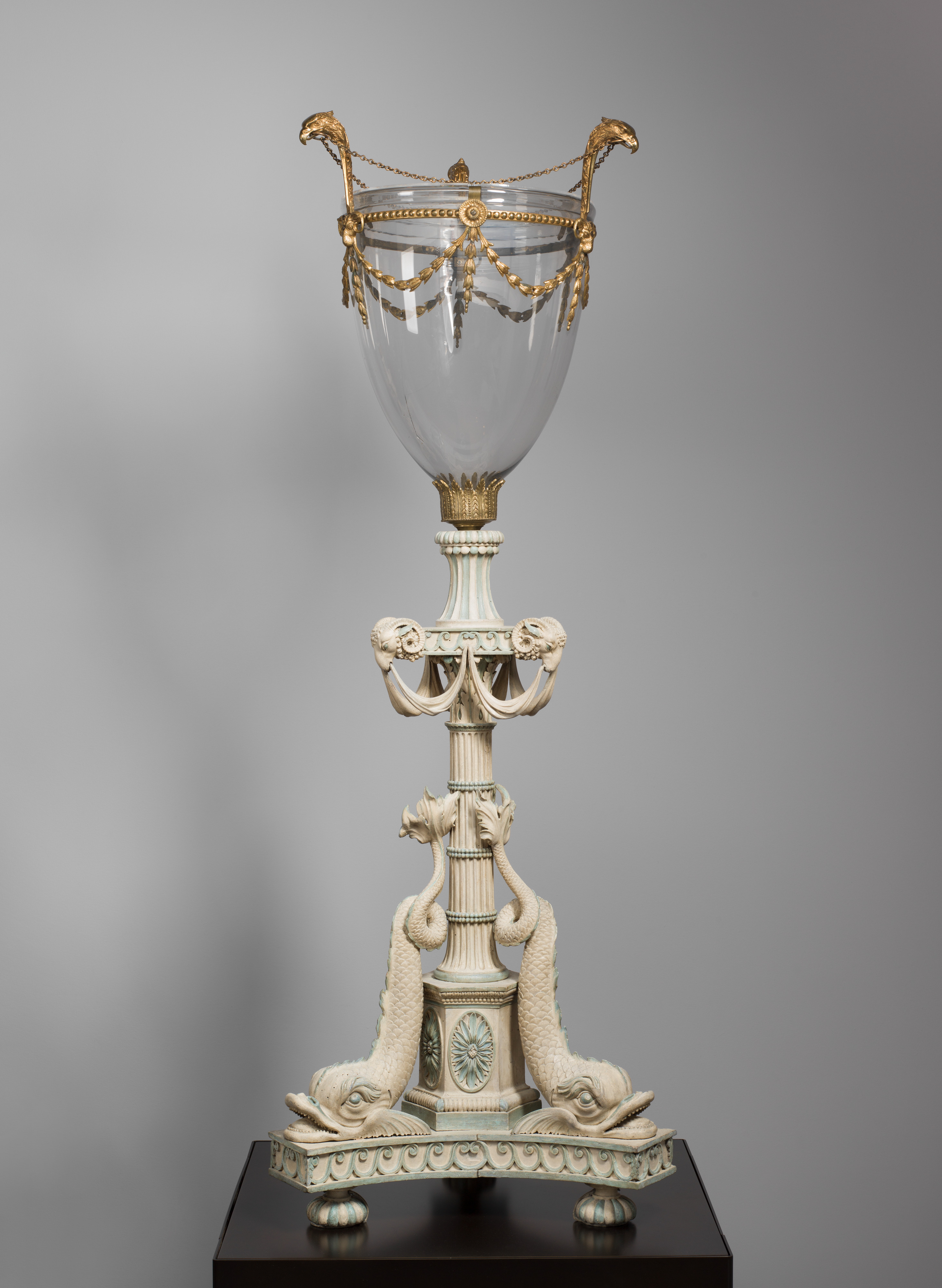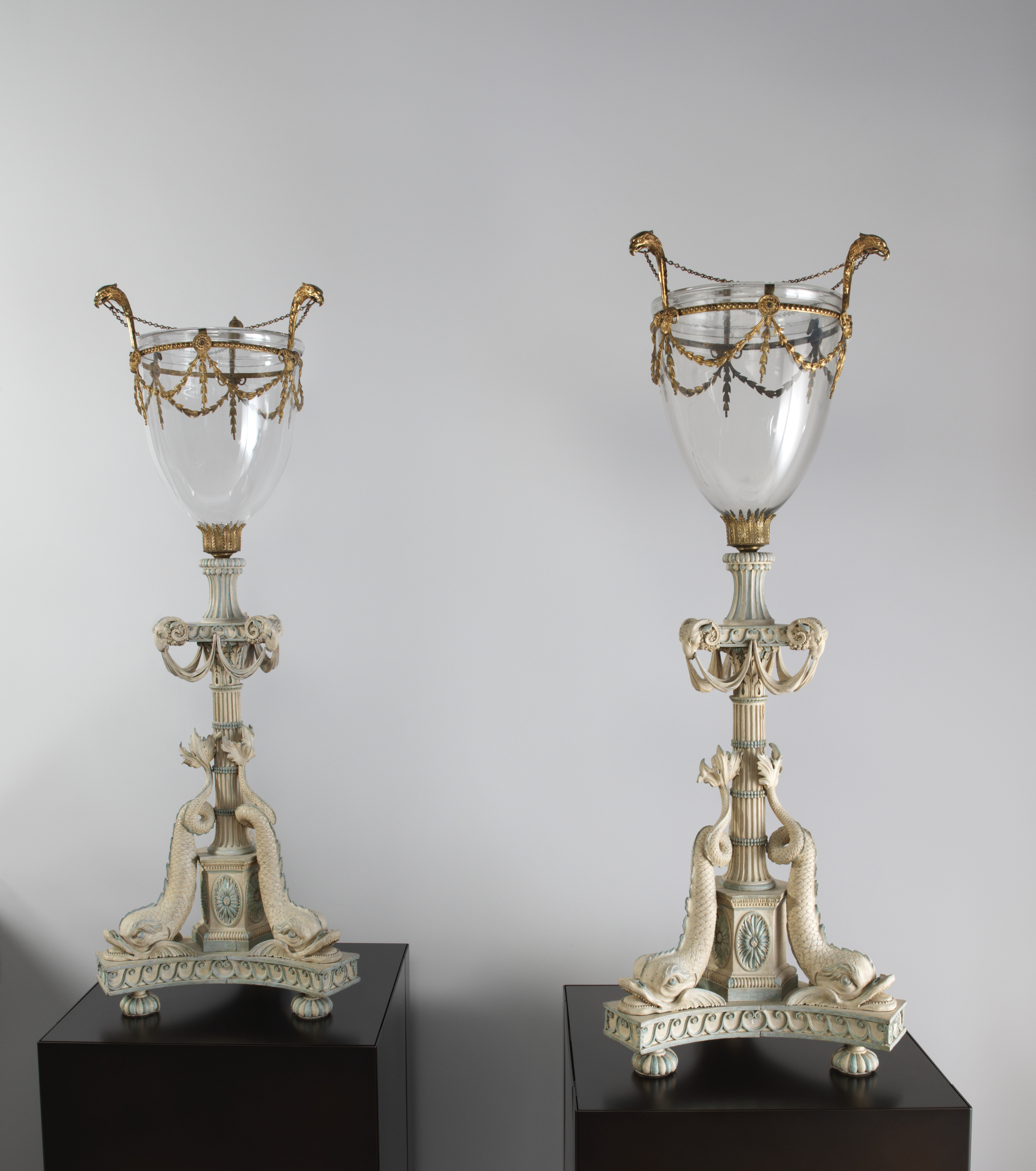Candlestand (one of a pair)
Before the introduction of the Argand oil lamp in 1784 and of later technological innovations such as gas and electric lighting, the artificial illumination of the domestic interior depended largely on candles, made either of rendered animal fat (tallow) or of less smoky and better-smelling beeswax.[1] Given the high cost especially of the wax kind, few candles were used on a daily basis, and once daylight faded the houses were dimly lit. Only at formal entertainments, such as important dinners and balls, would multiple candles-placed in magnificent chandeliers and girandoles-burn in the reception rooms. In addition to these hanging or mounted sources of light, candelabra and candlesticks would be brought in to brighten these rooms, especially in areas that would otherwise remain dark. They might be arranged on tables and mantelpieces and were often placed on tall movable candlestands with flat tops, also known as torchères. During the mid-eighteenth century, English pattern books included pictures of elaborately carved candlestands of spirited Rococo design [2], which were superseded by others in a more restrained Neo-classical style, such as this elegant example, one of a pair from the Irwin Untermyer collection.[3] With their delightful design and light painted colors, these torchères stood out amid the somber furnishings of the large Oak Room in Judge Untermyer's Fifth Avenue apartment.
Unfortunately, nothing is known about either the maker or the origin of these candlestands. Made of soft basswood, which has a fine texture and even grain very suitable for carving and staining, the torchères have kept their eighteenth-century color scheme of pale gray and light blue, which must have been in harmony with the decor of the interior they were originally commissioned for. Three dolphins descend upon a triangular base, carved with an adaptation of the Vitruvian scroll, which is resting on three fluted, bun-shaped feet. The uplifted tails of the scaly dolphins are lightheartedly twisted and rest against the banded and fluted column that forms the main upright of the stands. Unlike most torchères, these stands have candleholders on top, inside glass shades that are an intrinsic part of their design. [4] Three rams' heads holding drapery festoons are carved at the corners of a triangular platform that surmounts the shaft. The shape of these pendant swags is playfully echoed above, in the shape of the gilt-bronze husk festoons hung from rams' heads on the glass globe and also in the chains that are suspended between the griffins above the shade.[5]
Dolphins were a popular decorative motif in mid-eighteenth-century English designs of many kinds, including furniture. Particularly notable examples are the 1758 design for a candlestand by Thomas Johnson (1714-ca. 1778) and the set of four torchères with two dolphins entwined around their central support, from Hagley Hall, Worcestershire, that are based on it. [6] A simplified design was included in the third edition of The Gentleman and Cabinet-Maker's Director by Thomas Chippendale (1718-1779), published in 1762. [7] The architect James Stuart (1713-1788), an early proponent of the Greek Revival style, further propagated the use of the motif through his influential four-volume publication, The Antiquities of Athens, with measured drawings by Nicholas Revett (1720-1804). The Choragic Monument of Lysicrates was illustrated in the first volume of 1762 with a reconstruction of its top that included dolphins supporting a tripod stand.[8] It is possible that the unknown maker of the Museum's candlestands was familiar not only with Johnson's overwrought work but also with Chippendale's and with Stuart and Revett's publications. The use of such classically inspired ornaments as the Vitruvian scroll, the husk festoons, and the rams' heads with the pendant swags also reveals the influence of Robert Adam (1728-1792), the prominent architect and designer whose sophisticated and elegant style dominated the English arts during the 1770s and 1780s.
Since one side of each base has been left uncarved, these torchères were clearly meant to stand in a niche or to be placed against the wall, probably on triangular bases. Eliminating drafts and protecting passersby from smoke and the wooden stands, which are difficult to clean, from falling wax, the glass shades were both practical and also beautiful when the light was reflected in their shimmering surfaces. Unlike the constant glare of electric light, the dancing flames of candles and the shadows they created must have emphasized-perhaps even exaggerated-the bold carvings of these candlestands and brought the dolphins, albeit temporarily, to life.
Footnotes:
1. For the history of lighting, see Laing 1982; Bourne and Brett 1991; and Country House Lighting 1992.
2. Ince and Mayhew 1759-62 (1960 ed.), pls. LXVII-LXIX; Chippendale 1762, pls. CXLIV-CXLVII; and Hayward 1964, pls. 13-15.
3. Hackenbroch 1958a, p. 43, pl. 175, fig. 211; and Metropolitan Museum of Art 1977, p. 99, no. 180 (entry by William Rieder). The accession number of the pair to this candlestand is 64.101.1059a,b.
4. One design by Thomas Chippendale for candlestands was "intended for a Glass Globe, fixed at the Bottom in a Piece of Ornament"; Chippendale 1762, pl. CXLVII.
5. Similar glass globes, but without the griffins or the chains, resting on a tripod base, are placed on candlestands in the saloon of Culzean Castle, Ayreshire, Scotland; Learmont and Riddle 1985, p. 17.
6. Both the design and one of the candlestands based on it are illustrated in Wilk 1996, pp. 110-11 (entry by Catherine S. Hay).
7. Chippendale 1762, pl. CXLV.
8. Stuart and Revett 1825, vol. 1, pl. XXII. The conjectural tripod is known to have inspired a number of perfume burners executed in gilded bronze; N. Goodison 1972, pp. 695-704, figs. 56, 64, 65, 75. The monument is also thought to have inspired Robert Adam's design for a state bed for Robert Child at Osterley Park, Middlesex; Tomlin 1982, pp. 62-64, no. H/I.
Due to rights restrictions, this image cannot be enlarged, viewed at full screen, or downloaded.
This artwork is meant to be viewed from right to left. Scroll left to view more.






